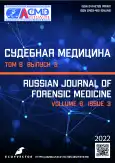Application of cytological research methods to solve the question of the organic origin of animal horns
- Authors: Maltseva A.Y.1, Stolyarov A.P.1
-
Affiliations:
- The Regional Forensic Medical Examination Bureau
- Issue: Vol 8, No 3 (2022)
- Pages: 93-98
- Section: Case reports
- URL: https://journals.rcsi.science/2411-8729/article/view/122480
- DOI: https://doi.org/10.17816/fm704
- ID: 122480
Cite item
Full Text
Abstract
Conducting forensic examinations is the leading evidentiary mechanism in the investigation and disclosure of poaching cases. During the investigation, animal derivatives (horns, hooves, and feathers) are found and seized from poachers in addition to clothing, crime instruments, and animal carcasses. Currently, the expensive horns of artiodactyls are of the greatest value for extraction, and their quality is largely determined by the correctness of processing from the remnants of blood, skin, and hair. Such processing precludes the use of biological methods of analysis to determine the organic origin of the seized derivatives, and genetic examination is complicated by the lack of proper laboratory equipment, appropriate reagents, and the high cost of analysis.
The expert of the forensic biological department of the State Medical Institution of the Penza region should have established the organic origin of animal horns, presumably saiga, based on the decision on the examination appointment. The study included14 pieces of animal horns seized from persons suspected of poaching.
Microparticles were obtained from the peripheral and central parts of the horns, from which pressed preparations were prepared, followed by their staining and microscopy during the study. Luminescent microscopy of preparations from solid plates of the central part of the horn stained with fluorochromes revealed osteocytes, which are cellular characteristics of bone tissue. Epithelial cells that form the basis of the horn cover were detected when azur-eosin stained small particles from the peripheral part of the horn.
The identification of these cell types provides sufficient grounds to conclude the organic origin of the horns presented for research.
Keywords
Full Text
##article.viewOnOriginalSite##About the authors
Anastasiya Y. Maltseva
The Regional Forensic Medical Examination Bureau
Author for correspondence.
Email: istudiante@mail.ru
ORCID iD: 0000-0001-6466-1500
SPIN-code: 6920-3155
Russian Federation, Penza
Arkadiy P. Stolyarov
The Regional Forensic Medical Examination Bureau
Email: sudmed_penza@mail.ru
ORCID iD: 0000-0001-6946-9059
MD, Cand. Sci (Med.)
Russian Federation, PenzaReferences
- Dmitrieva OA, Fomenko PV, Aramilev SV; World Wildlife Fund (WWF). Fundamentals of wild animal expertise. Vladivostok: Apel’sin; 2012. 127 p. (In Russ).
- Barsegyants LO. Forensic examination of physical evidence (blood, secretions, hair). Moscow: Meditsina; 2005. 448 p. (In Russ).
- Urazalina AS, Lyaipol’d IN. Identification of biological remains of an animal. Topical issues of veterinary medicine and biotechnology: ideas of young researchers: materials of the student scientific conference; 28 mar 2018; Chelyabinsk: South Ural State Agrarian University; 2018. Р. 263–270. (In Russ).
- Bannikov AG, Zhirnov LV, Lebedeva LS, Fandeev AA. Biology of the saiga. Moscow: Sel’khozizdat; 1961. 336 p. (In Russ).
- Davletov ZK. Commodity science and technology of processing meat game, wild food products and medicinal and technical raw materials: textbook. Saint Petersburg: Lan’; 2015. 424 p. (In Russ).
- Minoranskiy VA, Dankov VI. Saigatatarica L. Russia’s endangered species. Yug Rossii: ehkologiya, razvitie. 2016;11(1):88–103. (In Russ). doi: 10.18470/1992-1098-2016-1-88-103
- Dzerzhinskiy FY. Comparative anatomy of vertebrates: textbook for university students Moscow: Aspekt Progress; 2005. 304 p. (In Russ).
- Lysov VF, Ippolitova TV, Maksimov VI, Shevelev NS. Physiology and ethology of animals Moscow: KolosS; 2012. 604 p. (In Russ).
- Oshkina EA. Solid formations of the epidermis. Materials of the 63rd intra-university Student Conference: collection of articles. Vol. 3. Ulyanovsk: Ulyanovsk State Agricultural Academy named after P.A. Stolypin; 2010. Р. 105–107. (In Russ).
- Fedorovtsev AL, Revnitskaya LA, Koroleva EI, Ehdelev NS. Forensic medical cytological studies of traces on physical evidence. Nizhniy Novgorod: Povolzh’e; 2009. 152 p. (In Russ).
Supplementary files










